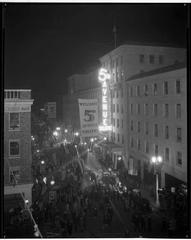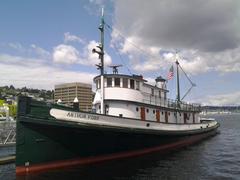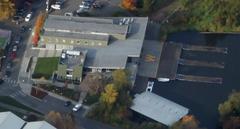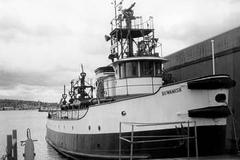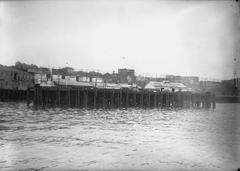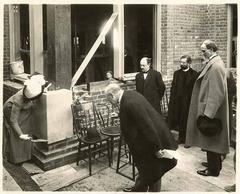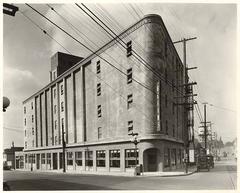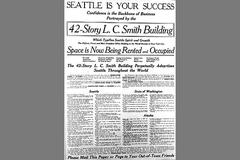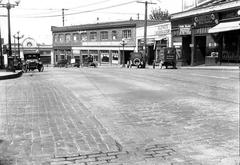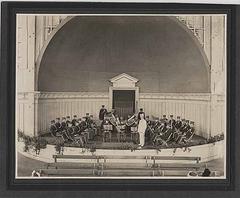
Alaskan Way Viaduct and Seattle Waterfront Transformation: Comprehensive Visiting Guide
Date: 04/07/2025
Introduction
Seattle’s Alaskan Way Viaduct, once a prominent double-decker freeway framing the city’s waterfront, played a critical role in Seattle’s urban development for over sixty years. Originally constructed in response to mounting downtown traffic and completed between 1949 and 1966, the viaduct carried tens of thousands of vehicles daily and dramatically shaped the city’s relationship with Elliott Bay (HistoryLink, Seattle Times, WSDOT). However, its imposing structure also created a formidable barrier that limited access to the waterfront and stifled the area’s potential for public enjoyment and ecological health (Waterfront Seattle, KUOW).
After the Nisqually Earthquake in 2001 exposed the viaduct’s seismic vulnerabilities and ignited extensive public debate, Seattle embarked on a bold plan to replace the viaduct with the SR 99 deep-bore tunnel. The tunnel opened in 2019, and the subsequent demolition of the viaduct paved the way for a landmark waterfront revitalization project.
Today, the corridor is home to a 20-acre Waterfront Park, featuring pedestrian promenades, public art, green spaces, and the iconic Overlook Walk—a new grand pedestrian bridge offering panoramic views and direct connections between Pike Place Market and Elliott Bay (Waterfront Park Seattle, SDOT Blog). This guide provides an in-depth look at the site’s history, key visitor information, travel tips, and nearby attractions to help you make the most of your Seattle waterfront experience.
Table of Contents
- Introduction
- Historical Background: Viaduct Conception, Construction, and Urban Impact
- The Push for Replacement and Demolition
- The Waterfront Today: Features, Hours, and Accessibility
- Arts, Culture, and Community Programming
- Accessibility and Sustainability
- Visitor Tips: Hours, Tickets, Transportation, and Family Features
- Upcoming Highlights and Events
- FAQ: Plan Your Visit
- Conclusion and Recommendations
- Sources
Historical Background: Viaduct Conception, Construction, and Urban Impact
The Alaskan Way Viaduct emerged from 1930s plans to address Seattle’s traffic congestion. Construction began in 1950, and the central span opened in 1953, with subsequent extensions completed by 1966 (HistoryLink, Seattle Times). The viaduct ran 2.2 miles along the waterfront, carrying U.S. Route 99 and later State Route 99, serving as a vital passage for up to 110,000 vehicles per day (WSDOT, Wikipedia).
Despite its utility, the viaduct’s design reflected mid-century priorities that favored cars over pedestrian access and environmental considerations (CNU). Its presence cast long shadows, physically separated downtown from the bay, and limited public engagement with the waterfront.
The Push for Replacement and Demolition
The 2001 Nisqually Earthquake dramatically highlighted the viaduct’s seismic risks, leading to a decade-long civic debate over its replacement. Through public votes and long negotiations, Seattle rejected both a new elevated highway and a shallow cut-and-cover tunnel. Ultimately, a deep-bore tunnel was chosen in 2009, funded with $2.8 billion in state money (Wikipedia).
The viaduct closed permanently in January 2019. Its demolition was a carefully orchestrated process, dismantling 1.4 miles of concrete structure without explosives to protect adjacent historic districts and active rail lines. Nearly all demolition materials were recycled (IBTTA).
The Waterfront Today: Features, Hours, and Accessibility
Overlook Walk
The Overlook Walk is the crown jewel of the new waterfront. Opened in October 2024, this elevated bridge and park connects Pike Place Market with the waterfront, bridging nearly 100 feet in elevation. Visitors enjoy 360-degree views of Elliott Bay, the Olympic Mountains, Mount Rainier, and the Seattle skyline.
Features:
- Landscaped terraces with native plants
- Family-friendly amenities (slide, climbing wall)
- Accessible pathways and elevators
- Ample seating and covered gathering spaces
Hours: 7 am – 10 pm daily (Waterfront Park Seattle).
Pier 62
Pier 62 is a revitalized community hub, reopened in 2020. It hosts free public events, outdoor markets, concerts, and wellness classes. The floating dock provides water access and scenic views.
Pioneer Square Habitat Beach
Opened in 2023, Pioneer Square Habitat Beach restores shoreline ecology, supports salmon passage, and offers peaceful bay access close to historic Pioneer Square.
Promenade and Historic Piers
The waterfront promenade is a pedestrian-friendly boulevard lined with shops, cafes, and public art. Railroad Way South features tree-lined paths and rotating Indigenous art installations.
Iconic piers continue to offer:
- The Seattle Great Wheel for panoramic rides
- Waterfront dining and shopping
- Access to ferries, water taxis, and cruise terminals
Seattle Aquarium Ocean Pavilion
The Seattle Aquarium Ocean Pavilion opened in 2025, expanding the aquarium’s mission with immersive exhibits featuring sharks, rays, coral species, and more. Art by Dan Friday (Lummi Nation) honors Coast Salish stewardship.
Tickets: Required for entry, available online or at the entrance. Pricing details are updated on the official aquarium website.
Arts, Culture, and Community Programming
The waterfront features permanent and rotating public art, with a strong focus on Indigenous artists (Waterfront Park Seattle). Upcoming highlights include a sculptural playground at Pier 58 and the Cannonball Arts venue in partnership with the Muckleshoot Indian Tribe (Visit Seattle). Friends of Waterfront Park curate more than 270 free events annually, including concerts, dance, markets, and wellness activities (Waterfront Park Seattle).
Accessibility and Sustainability
Accessibility is a core part of the design, with elevators, sloped walkways, and seamless connections between Pike Place Market and the waterfront (SDOT Blog). Habitat restoration at beaches and along the shoreline supports native species, and landscaping uses drought-tolerant plants native to the region.
Visitor Tips: Hours, Tickets, Transportation, and Family Features
- Hours: Most public spaces, including Overlook Walk and Pier 62, are open daily from 7 am – 10 pm.
- Tickets: Access to Waterfront Park, Overlook Walk, and most piers is free. Paid admission is required for the Seattle Aquarium Ocean Pavilion.
- Getting There: Easy access by foot, bike, bus, and streetcar. The free Waterfront Shuttle operates daily during peak months, connecting major attractions (Seattle Waterfront).
- Parking: Street parking starts at $1.00/hour, with free parking on Sundays and evenings (Seattle Waterfront).
- Cycling: Protected bike lanes run from Pier 50 to Pier 62. Note: Bicycles are not allowed on the promenade and boardwalk between the stadiums and Overlook Walk (Seattle Waterfront).
- Family-Friendly: Playgrounds, interactive art, and plenty of open space for kids.
- Dining and Shopping: Numerous waterfront restaurants, cafes, and shops.
- Weather: Seattle weather can change quickly—bring layers and a rain jacket (AplusNW).
- Safety: The area is actively managed for cleanliness and security (SDOT Blog).
Upcoming Highlights and Events
- Pier 58: Opening soon, this will feature a playground, lawn, grove, and signature jellyfish sculpture (Visit Seattle).
- Cannonball Arts: New arts venue opening in spring 2025 in partnership with the Muckleshoot Indian Tribe (Visit Seattle).
- Events: Check the Friends of Waterfront Park calendar for concerts, festivals, and wellness activities.
FAQ: Plan Your Visit
Q: What are the Seattle waterfront visiting hours?
A: Most public spaces are open daily from 7 am – 10 pm.
Q: Are tickets required for the Seattle Waterfront?
A: No tickets are needed for Waterfront Park and Overlook Walk. Attractions like the Seattle Aquarium Ocean Pavilion require paid admission.
Q: How do I get to the Seattle Waterfront?
A: On foot, by bike, public transit, or the free Waterfront Shuttle.
Q: Is the area accessible for people with disabilities?
A: Yes, with elevators, ramps, and accessible routes throughout the waterfront.
Q: What are the best places for photos?
A: Overlook Walk, Pier 62, and the promenade all offer excellent panoramic views.
Q: Are there guided tours?
A: Various providers offer walking and biking tours. Self-guided audio tours are available via the Audiala app.
Conclusion and Recommendations
Seattle’s transformation of the Alaskan Way Viaduct corridor into a vibrant, accessible waterfront park is a testament to the city’s forward-thinking urban planning and community engagement. Today’s waterfront honors its past while creating new opportunities for connection, recreation, and cultural expression.
Whether you’re interested in history, art, ecology, or just a stunning view, the Seattle waterfront welcomes you year-round. For the latest updates, ticket information, and event schedules, check official websites and download the Audiala app for self-guided tours and personalized recommendations. Share your waterfront moments on social media using #SeattleWaterfront!
Sources
- HistoryLink
- Seattle Times
- WSDOT
- Waterfront Park Seattle
- Wikipedia
- KUOW
- SDOT Blog
- Cascadia Daily
- IBTTA
- Waterfront Park Seattle Official Site
- Seattle Aquarium
- Visit Seattle
- KOMO News
- Seattle Waterfront
- FOX13 Seattle
- AplusNW
- World Landscape Architect




